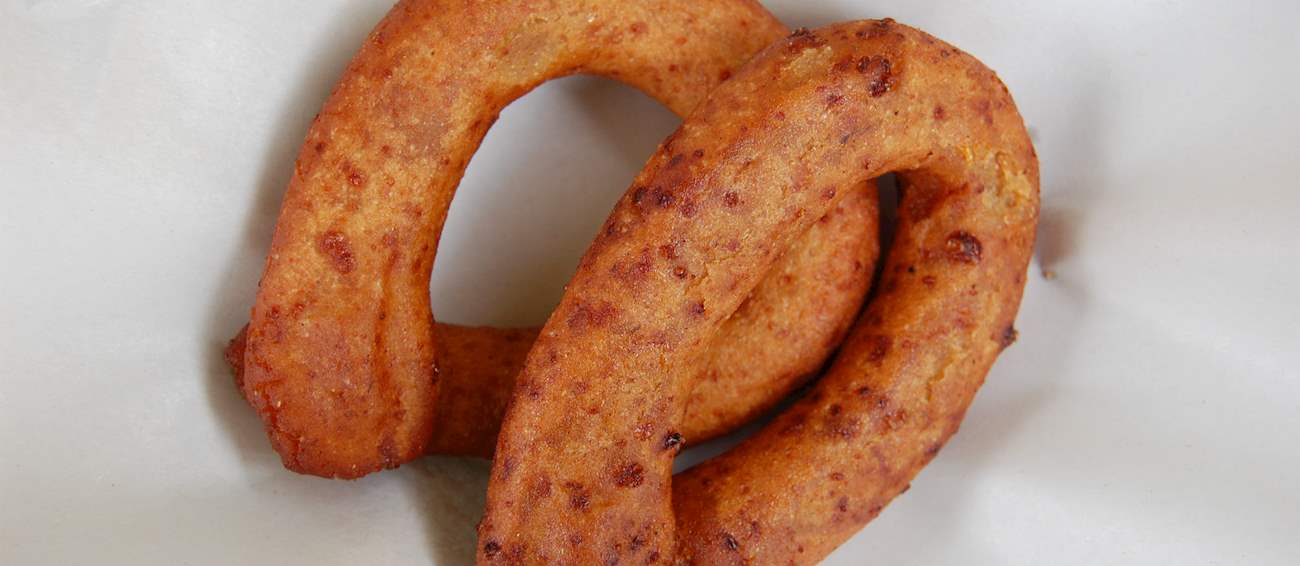Casabe is a traditional thin flatbread. It is made with flour gained from cassava, an ancient plant native to northern parts of South America. No leavening agent or fat is used in the preparation, and as a result, the bread has an unusually crispy texture.
This traditional delicacy has a distinctive taste, it is rarely eaten on its own and usually, like other bread varieties, it is eaten as an accompaniment to other dishes, most commonly stews and soups. Plain casabe is highly versatile and can be improved by either sweet or savory additions.
Mandoca is a Venezuelan dish originating from the region of Zulia. These elongated rings are made with a combination of cornmeal, plantains, panela sugar, water, and queso fresco. Once prepared, the dough is fried in hot oil until golden-brown.
Mandocas are traditionally served hot for breakfast, accompanied by cheese, butter, and coffee on the side.
MAIN INGREDIENTS
Sopa de mondongo is a term that is widely used all across Central and South America when referring to a hearty tripe and vegetable soup. The star of the dish is beef or pork tripe, the rather tough edible part of animal stomach which is cut into smaller pieces and cooked with other ingredients in a flavorful broth.
Different versions of the soup are found all across Latin America, where it has been adapted with locally available ingredients and spices. Typically, sopa de mondongo employs plain and sweet potatoes, cassava, corn, cabbage, plantains, onions, sliced avocado, and generous amounts of chopped cilantro, which is used as a garnish.
MAIN INGREDIENTS
Papitas de leche are traditional sweet treats (or milk truffles) originating from Venezuela. These small desserts are made with simple ingredients such as sugar, condensed milk, powdered milk, and cloves. Papitas de leche are instantly recognizable due to the cloves that are studded into the center of each papita.
The dry ingredients are first mixed in a bowl, and the condensed milk is added after that. The mixture should be smooth and firm. It’s rolled into small balls, and a clove is stuck into each papita de leche before they’re enjoyed. These small desserts are ideal for festive events and gatherings.
Often referred to as Venezuelan tamale, hallaca is an elaborate dish usually served as a part of a Christmas dinner. It consists of a stew-like filling, usually made with meat, which is wrapped in corn flour dough, placed into plantain leaves, then tightly wrapped and boiled.
The additional ingredients, often referred to as decorations, are placed on top of the stew and usually include olives, peppers, raisins, or even boiled eggs. There is a popular belief that the dish was invented by the Venezuelan slaves, who used the leftover ingredients provided by the wealthy landowners in order to create this unique Venezuelan dish.
MAIN INGREDIENTS
Arepa frita is a variety of Venezuelan arepas that is popular throughout the country, especially in the Zulia region. The arepa is traditionally grilled, dipped in batter, then deep-fried in hot oil. When it develops a golden-brown color, arepa frita is usually stuffed with cabbage, queso de mano, mortadella, and condiments such as ketchup, mustard, and mayonnaise.
Although it is typically filled, this variety of arepa can also be consumed on its own as a quick snack.
OTHER VARIATIONS OF Arepa
Caraotas negras is the Venezuelan name for black beans, also known as turtle beans. They are a part of the Venezuelan national dish called pabellon criollo, but can also be included in various soups or side dishes, and when refried they are an essential ingredient of empanadas or arepas.
Caraotas negras can also be used as a substitute for kidney beans in chili con carne, but they can also be cooked and served in cold salads. Generally speaking, black beans are indigenous to Central and South America and are called differently depending on the region: frijoles negros or caviar criollo. Its origins can be traced back to Mayan cuisine, which means they have been a part of the South American diet for nearly 4,000 years.
TasteAtlas food rankings are based on the ratings of the TasteAtlas audience, with a series of mechanisms that recognize real users and that ignore bot, nationalist or local patriotic ratings, and give additional value to the ratings of users that the system recognizes as knowledgeable. For the “7 Worst Rated Venezuelan Foods” list until April 20, 2025, 3,050 ratings were recorded, of which 833 were recognized by the system as legitimate. TasteAtlas Rankings should not be seen as the final global conclusion about food. Their purpose is to promote excellent local foods, instill pride in traditional dishes, and arouse curiosity about dishes you haven’t tried.




